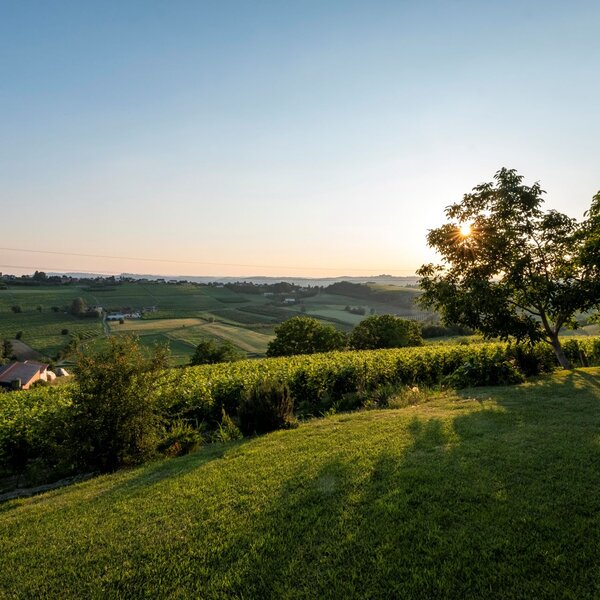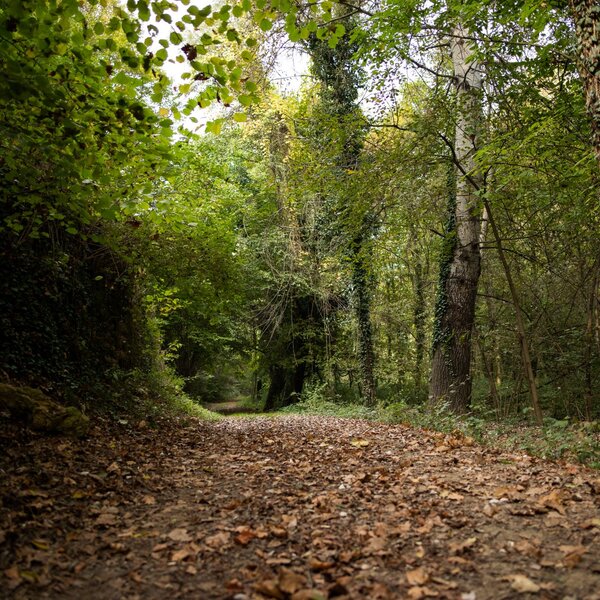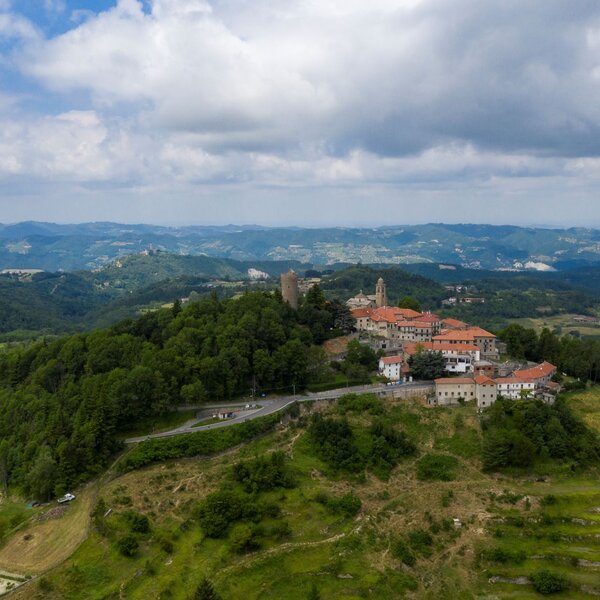The good old Nizza della Paglia (literally Nizza of the straw, the former name of Nizza Monferrato) is the perfect archetype of a provincial Savoy town: the high street, the residences of the nobility, the Foro Boario (cattle market), the main square. It is easy to lose track of time in its streets, watching the wooden signs of the shops and tasting its many typical products. All around the village, beyond the Nizza and Belbo streams which close it like a wedge, there is a sea of gentle hills and fertile plains which are a source of wealth and crops.
This is where the heart of old Piedmont beats, a heart all about Barbera with its own appellation which, ça va sans dire, could only be called “Nizza” and you can taste it at the Enoteca Regionale del Nizza (Regional Wine Centre) in Palazzo Crova.
Next, we leave Nizza Monferrato and follow the Bricco route where a romantic little Church surrounded by cypresses will take us, also visually, to the sea of vineyards that awaits us. Amidst hamlets and small country churches, the route continues towards Castelnuovo Calcea (see itinerary Monferrato of Costigliole d’Asti) and then turns right onto Via Momparone; soon it climbs uphill and almost turns back again to ride along one of the most scenic ridges of the Monferrato with the small, isolated hamlet of Noche, our next destination.
Find out more

Monferrato of Costigliole d'Asti
Find out moreFrom here the route takes you immediately past Vaglio Serra to descend in a few bends into the Val Sarmassa Nature Park (see itinerary The Parks of Monferrato Area) and then onto Incisa Scapaccino. Along the way you should definitely stop in Vinchio, the place most dear to Davide Lajolo’s heart.
Find out more

Parks of the Monferrato Area
Find out moreThe upper part of Incisa Scapaccino (the villa) is very beautiful (it was the seat of a marquisate of the Aleramici) and is worth a stroll through neo-Gothic palaces, noble residences, convents (the 15th century Sanctuary of the Madonna del Carmine, with important older frescoes, is a must) and surviving traces of the imposing fortifications of this historic Monferrato family. We quickly travel through the rest of the Belbo plain which has its landmark and focal point in Castelnuovo Belbo; here we find the Museum dedicated to Francesco Cirio (credited with being the father of canned foods) and the small panoramic country Church of Regina Angelorum, which dates back to the 14th century.
And next, we are in Bruno, a small municipality with the Cantina Comunale (Municipal Wine Centre) and the medieval Castle of the Faà family set at the far end of the Asti border on the Alessandria area. From here, right through the woods you can get to Mombaruzzo. This is one of the most historically-steeped villages in the Monferrato area. Situated on the "silk route" from Savona to Flanders, it used to have a large spinning mill. Today it is famous for its excellent soft amaretti (almond macaroons) which can be found anywhere in the village, and for the grappa. You can discover all secrets of this spirit visiting the beautiful Museo del Distillatore (Distiller Musem). Its historic heart lies in the Ricetto, the medieval fortification still enclosed within four ultra-high walls (some of which are still visible today) with just two entrance points, reminiscent of the two former gates. Inside we find the Church of the Maddalena, various medieval buildings (including Palazzo Marchionale and the Dacia and Ferraris houses), the Civic Tower commissioned by the Marquises of Monferrato in the 13th century, the Baroque ex-Confraternity of Sant'Andrea, the palace of the Marquises Pallavicini, the former nursery school, now the Museo del Territorio (Museum of the Territory) “Pinino Nota”, and the Church of Sant'Antonio Abate (14th century).
The villages around Mombaruzzo are all very pretty, immersed in the region's largest expanse of vineyards and equally divided between Barbera and Brachetto d'Acqui, a rare pink, sweet and aromatic grape variety.
Now we move on to Maranzana where, in the shadow of the Castle, we find the big "babaci" (rag dolls) telling the stories of the village, and the museum memories of the daring explorer Giacomo Bove; next we pass through Quaranti, the first of a series of smaller medieval fortifications, featuring the lovely panoramic Church of SS. Cosma and Damiano and the local Bottega del Vino (Wine Shop); then we reach Castelletto Molina, which is nestled around the turreted Castle with a curiously low shape, featuring the ancient small ecclesia castri chapel and the traditional Langhe game of pallapugno. The route then climbs up to Bricco Oddone, a beautiful spot overlooking the entire itinerary, and past Castel Rocchero, another medieval fortification whose main entrance vault is already set on the border with the Langhe.
Finally, we descend again towards the Fontanile Ricetto: its modern Church has slightly altered the medieval double-walled plan of the past (but we can still see part of the walls, the two gates and the only surviving tower). The "dome" of San Giovanni Battista (a 52 metres-dome with a 16 metre- diameter) is an eclectic work by the Bolognese artist Gualandi. A walk through the village will allow you to enjoy the installations "I Muri raccontano" (Walls tell a story), a creative way of enhancing the old town through art.
From Fontanile, passing through Castel Boglione, we travel along the valley of the Rio Bogliona stream to reach the former 15th-century Monastery, then we turn right and climb up to Montabone, an enclosed village which is already pure Langa as it is located on this intangible orographic border. Montabone is the hometown of Guglielmo Caccia, a prominent Counter-Reformation painter who was very active in and around Moncalvo, (that is why he was nicknamed “Il Moncalvo”). Here the view changes completely, and while one side overlooks the thousand hills of the Monferrato, the side towards the Bormida river and Acqui Terme drops steeply down the valley, while the other one, facing south-west, is relentlessly enclosed by the steep slope of Roccaverano (see itinerary Langa Astigiana from Roccaverano).
Find out more

Langa Astigiana in and around Roccaverano
Find out moreLast but not least, the small stone church of San Vittore, isolated on its panoramic hillock for 600 years, and the former Church of San Rocco with the installation “A Cheerful Person” of Zhang Enli, are well worth a visit.
We descend fairly quickly towards Rocchetta Palafea (another border village) with its beautiful stone tower (26 metres), baroque parish Church and the proud home of Massimo Berruti, the local champion of pallapugno. The vineyards clearly reappear now, as we drive along the fantastic Serra road which descends like a funicular railway straight into Calamandrana Alta, a small enchanted village where the castle, garden, churches, wine shop and the only street form all together a homogeneous body steeped in poetry. Calamandrana Bassa, on the other hand, is home to the annual gathering of truffle hunters who meet up here at the end of the season (January). On the other side of the Belbo, it is worth visiting the Romanesque Church of San Giovanni delle Conche where, according to legend, the founders of Nizza gathered in 1225.
Finally, we travel along the "old route" to return to Nizza Monferrato on a journey through space and time which, in a few kilometres, will take us back to the Campanon of the Town Hall, the undisputed symbol of the city and of its centuries-old freedoms.
PLEASE NOTE: Responsibility for the maintenance and practicability of the various trails lies with the municipalities where the routes are located. The Tourist Board, therefore, cannot be held responsible for any inefficiencies, but is willingly available to collect your reports so that they can be forwarded to the authorities concerned.


